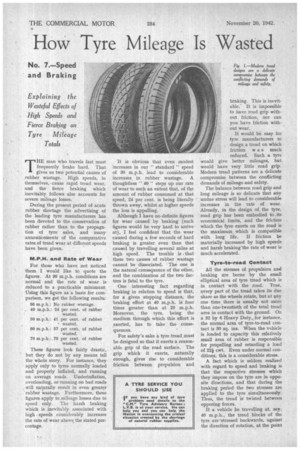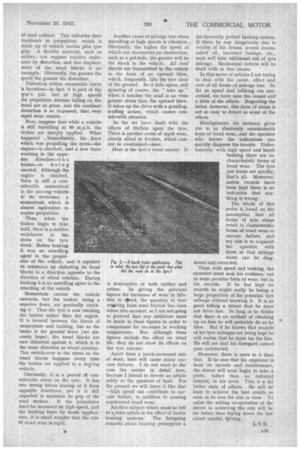How Tyre Mileage I Wasted
Page 32

Page 35

If you've noticed an error in this article please click here to report it so we can fix it.
No. 7.—Speed and Braking
Explaining the Wasteful Effects of High Speeds and Fierce Braking on Tyre Mileage Totals
THE man who travels fast must frequently brake hard. That gives us two potential cause's of rubber wastage. High speeds, in themselves, cause rapid tread wear, and the fierce braking which inevitably follows also accounts for severe mileage losses,
During the present period of acute rubber shortage the advertising of the leading tyre manufacturers has been devoted to the conservation of rubber rather than to the propagation of tyre sales, and many announcements of the comparative rates, of tread wear at different speeds have been given.
M.P.H. and Rate of Wear For those who have not noticed them I would like to quote the figures. At 30 m.p.h. conditions are normal and the rate of wear is reduced to a practicable minimunt. Using this figure as 'a. basis for comparison, we get the following results: 30 m.p.h.: No rubber wastage.
• 90 m.p.h.: 24 per cent, of rubber
• wasted.
50 m.p.h.: 91 per cent, of rubber • wasted. 60 m.p.h.: 57 per cent, of rubber wasted.
70 m.p.h.: .70 per cent. of rubber wasted.
These figures look fairly drastic, but they do not by any means tell the whole story. For instance, they apply only to tyres normally loaded and properly inflated, and running on average roads. Underinflation, overloading, or running on bad roads will naturally result in even greater 'rubber wastage. Furthermore, these figures apply to mileage losses due to speed only. The harsh braking which is inevitably associated with high speeds considerably increases the rate of wear above, the stated percentage.
It is obvious that even modest increases in our " standard " speed of 30 m.p.h. lead to considerable increases, in rubber wastage. A thoughtless " 40 " steps up our rate of wear to such an extent that, of the amount of rubber consumed at that speed, 24 per cent. is being literally thrown away, whilst at higher speeds the loss is appalling.
Although I have no definite figures fqr wear caused by braking (such figures would be very hard to arrive at), I feel confident that the wear caused during a few seconds of hard braking is greater even than that caused by travelling several miles at high speed. The trouble is . that these two causes of rubber wastage cannot be dissociated. The one, is the natural consequence of the other, and the combination of the two factors is fatal to the tyre.
One interesting fact regarding braking in relation to speed is that, for a given stopping distance, the braking effort at 40 m.p.h. is four times greater than at 20 m.p.h. Moreover, the tyre, being the medium through which this effort is exerted, has to take the consequences.
For safety's sake a tyre tread,must be designed so that it exerts a reasonable grip of the road surface. The grip which it exerts, naturally enough, gives rise to considerable friction between propulsion and braking. This is inevitable,' It is impossible to have road grip without friction, nor can you have friction without wear.
It would be easy for tyre manufacturers to desigha tread on which friction w a s much reduced. Such a tyre would give better mileages, but would have very little road grip. Modem tread patterns are a delicate compromise between the conflicting demands of mileage and safety. • The balance between road grip and long mileage is so delicate that any undue stress will lead to considerable increases in the rate of wear. Already, in the design of. the tyre, road grip has been embodied to ,its economical limits, and the friction . which the tyre exerts on the road is the maximum which is compatible with long life. If friction be materially increased by high speeds and harsh braking-the rate of wear is much accelerated.
Tyre-to-road Contact
All the stresses of propulsion and braking are borne by the small -elliptical area of tyre tread which is in contact with the road. True, every part of the tread takes its due, share as the wheels rotate, but at any one time there is usually not more than one-twentieth of the total tread area in contact with the ground. On a 32 by S Heavy Duty, for instance, the normal area of tyre-to-road contact is 30 sq. ins. When the vehicle is loaded to capacity this relatively small area of rubber is responsible for propelling and retarding a load of 221 cwt. Even under normal conditions, this is a considerable stress.
A fact which is seldom realized with regard to speed and braking is that the respective stresses which they impose on the tyre are in opposite directions, and that during the braking, period the two stresses are applied to the tyre simultaneously: Thus, the tread is twisted between opposing forces.
If a vehicle jzie travelling at, say, 40 m.p.h., the tread blocks of the tyre are 'stressed backwards, against the direction of rotation, at the point
of road contact. This indicates their resistance to prOpulsion, which is made up of vehicle inertia plus tyre grip. A flexible material, such as rubber, can register tractive resistance by distortion, and this displacement of the tread blocks is an example. Obviously, the greater the speed the greater the distortion.
Distortion within reasonable limits is harmless—in fact, it is part of the tyre's job; but at high speeds the propulsion stresses falling on the tread are so great, and the resultant distortion is so increased, that very rapid wear results.
Now, suppose that while a vehicle is still travelling at 40 m.p.h. the brakes are sharply applied. What happens? . Immediately, the force which was propelling the tyres—the engine—is checked, and a new force working in the opposite direction—t h e brakes—is being exerted. Although the engine is checked, there is still a con siderable momentum in the moving vehicle to be overcome, a momentum which is almost equivalent . to • engine propulsion. Thus, when the brakes begin to take .
hold, there is a sudden switchover in the stress on the tyre tread.. Before braking it was an unwilling agent in the propulsion of the vehicle, and it signified its resistance by distorting its tread blocks in a direction opposite to the direction of wheel rotation. During braking it is an unwilling agent in the retarding of the vehicle.
Momentum carries the vehicle onwards, but the brakes, being a superior force, are' gradually checking it. Thus the tyre is now resisting the brakes rather than the enginb. It is twisted between the forces of momentum and braking, but as the brake is the greater force (we sincerely hope), the tread blocks are now distorted against it, which is in the same direction as wheel rotation. This switch-over in the stress on the tread blocks happens every time the brakes are applied to a raving vehicle. .
Obviously, it is a period cff considerable stress on the tyre. It has two strong forces tearing at it from opposite directions, yet it is still expected to maintain its grip of the mad surface. If the propulsion force be increased by high speed, and the braking force by harsh application, it is small wonder that the rate if tread wear is rapid.
Another cause of mileage loss when travelling at high speeds is vibration.... Obviously, the higher the speed at which one encounters an obstruction, such as a pot-hole, the greater will be the shock to the vehicle. All road shocks are transmitted to the vehicle in the form of an upward blow, which, frequently, lifts the tyre clear of the ground. As it falls again, still spinning of course, the "take up" when it touches the road is an even greater stress than the upward blow. It takes up the drive with a grinding, scuffing action, which causes considerable abrasion.
So far we have dealt With the effects of friction upon the • tyre. There is another cause of rapid wear, closely allied to friction, which cannot be overlooked—heat.
Heat is the tyre's worst enemy. It
is destructive of both rubber and cotton. In giving the previous figures for increases of wear in teatidn to steed, the question of heat resislting from mad friction 'has been taken into account, so I am not going to pretend that any additions must be made to these figures in order to compensate for increases in working temperature. But, although these figures include the effect on tread life, they do not show its effects on the tyre carcase.
Apart from a much-increased rate of wear, heat will cause many carcase failures. I do not want to discuss the matter in detail here, because I intend to devote an article solely to the question of heat. For the present we will leave it like that —high speed can contribute to carcase failure, in addition to causing accelerated tread wear.
Another subject which must be left to a later article is the effect of faulty braking systems. The foregoing remarks about braking presuppose a mechanically perfect braking system. If there be any irregularity due to ovality of the drums, scored drums, caked oil, incorrect linkage, etc., each will take additional toll of tyre mileage. Mechanical defects will be dealt with in due course.
In this series of articles I am trying to deal with the cause, effect and cure of all forms og mileage loss. So far as speed and biaking are concerned, we have seen the causes and a little of the effects. Regarding the latter, however, this form of abuse is not so easy to detect as some of the others.
Misalignment, for instance, gives rise to an absolutely unmistakable form of tread wear. .and the operator who knows the indications can quickly diagnose the trouble. Unfortunately, with high speed and harsh braking there are no characteristic forms of tread wear. The tyre just wears out quickly, that's all. Moreover, unless records have been kept there is no indication that anything is wrong.
The whole of this series is based on the assumption that all forms of tyre abuse result in characteristic forms of tread wear or carcase failure, and my aim is to acquaint the operator with these so that mileage waste can be diag nosed and corrected.
Thus, with speed and braking, the 'operator must seek his evidence, not in some peculiar form of wear, but in his records.. If he has kept no records he might easily be losing a' large proportion of his potential tyre mileage without knowing it. It is no good telling a driver that he must not drive fast. So long as he thinks that there is no method of checking up on him he will probably do as he likes. But if he knows that recorda of his tyre mileages are being kept he' will realize that he must toe the line. He will see that his disregard cannot pass undetected.
However, there is more to it than that. If he sees that his employer is keen on records and maintenance, the .driver will soon begin to take a pride, rather than an enforced interest, in his tyres. This is a far better state of affairs. He will be keen to achieve the best results so soon as he sees the aim in view. To enlist the willing co-operation of the driver in achieving the aim will be far better than laying down the law about careful driving.




























































